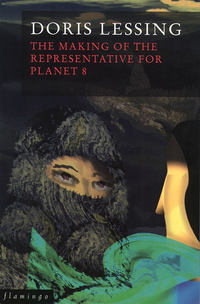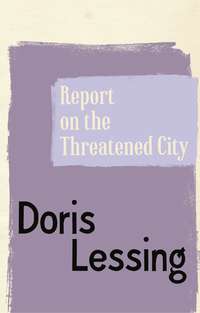
Полная версия
Shikasta
During the years following the end of World War II, there were many ‘small’ wars, some as vicious and extensive as wars in the recent past described as major. The needs of the armament industries, as much as ideology, dictated the form and intensities of these wars. During this period savage exterminations of previously autonomous ‘primitive’ peoples took place, mostly in the Isolated Southern Continent (otherwise known as Southern Continent II). During this period colonial risings were used by all the major powers for their own purposes. During this period psychological methods of warfare and control of civilian populations developed to an extent previously undreamed of.
Here we must attempt to underline another point which it is almost impossible for those with our set of mind to appreciate.
When a war was over, or a phase of war, with its submersion in the barbarous, the savage, the degrading, Shikastans were nearly all able to perform some sort of mental realignment that caused them to ‘forget’. This did not mean that wars were not idols, subjects for pious mental exercises of all sorts. Heroisms and escapes and braveries of local and limited kinds were raised into national preoccupations, which were in fact forms of religion. But this not only did not assist, but prevented, an understanding of how the fabric of cultures had been attacked and destroyed. After each war, a renewed descent into barbarism was sharply visible – but apparently cause and effect were not connected, in the minds of Shikastans.
After World War II, in the Northwest fringes and in the Isolated Northern Continent, corruption, the low level of public life, was obvious. The two ‘minor’ wars conducted by the Isolated Northern Continent reduced its governmental agencies, even those visible and presented to the public inspection, to public scandal. Leaders of the nation were murdered. Bribery, looting, theft, from the top of the pyramids of power to the bottom, were the norm. People were taught to live for their own advancement and the acquisition of goods. Consumption of food, drink, every possible commodity was built into the economic structure of every society. [VOL. 3009, Economies of Affluence.] And yet these repulsive symptoms of decay were not seen as direct consequences of the wars that ruled their lives.
During the whole of the Century of Destruction, there were sudden reversals: treaties between nations which had been at war, so that these turned their hostilities on nations only recently allies; secret treaties between nations actually at war; enemies and allies constantly changing positions, proving that the governing factor was in the need for war, as such. During this period every major city in the northern hemisphere lived inside a ring of terror: each had anything up to thirty weapons aimed at it, every one of which could reduce it and its inhabitants to ash in seconds – pointed from artificial satellites in the skies, directed from underwater ships that ceaselessly patrolled the seas, directed from land bases perhaps halfway across the globe. These were controlled by machines which everyone knew were not infallible – and everybody knew that more than once the destruction of cities and areas had been avoided by a ‘miracle’. But the populations were never told how often these ‘miracles’ had taken place – near-lethal accidents between machines in the skies, collisions between machines under the oceans, weapons only just not unleashed from the power bases. Looking from outside at this planet it was as if at a totally crazed species.
In large parts of the northern hemisphere was a standard of living that had recently belonged only to emperors and their courts. Particularly in the Isolated Northern Continent, the wealth was a scandal, even to many of their own citizens. Poor people lived there as the rich have done in previous epochs. The continent was heaped with waste, with wreckage, with the spoils of the rest of the world. Around every city, town, even a minor settlement in a desert, rose middens full of discarded goods and food that in other less favoured parts of the globe would mean the difference between life and death to millions. Visitors to this continent marvelled – but at what people could be taught to believe was their due, and their right.
This dominant culture set the tone and standard for most of Shikasta. For regardless of the ideological label attaching to each national area, they all had in common that technology was the key to all good, and that good was always material increase, gain, comfort, pleasure. The real purposes of life – so long ago perverted, kept alive with such difficulty by us, maintained at such a cost – had been forgotten, were ridiculed by those who had ever heard of them, for distorted inklings of the truth remained in the religions. And all this time the earth was being despoiled. The minerals were being ripped out, the fuels wasted, the soils depleted by an improvident and short-sighted agriculture, the animals and plants slaughtered and destroyed, the seas being filled with filth and poison, the atmosphere was corrupted – and always, all the time, the propaganda machines thumped out: more, more, more, drink more, eat more, consume more, discard more – in a frenzy, a mania. These were maddened creatures, and the small voices that rose in protest were not enough to halt the processes that had been set in motion and were sustained by greed. By the lack of substance-of-we-feeling.
But the extreme riches of the northern hemisphere were not distributed evenly among their own populations, and the less favoured classes were increasingly in rebellion. The Isolated Northern Continent and the Northwest fringe areas also included large numbers of dark-skinned people brought in originally as cheap labour to do jobs disdained by the whites – and while these did gain, to an extent, some of the general affluence, it could be said that looking at Shikasta as a whole, it was the white-skinned that did well, the dark-skinned poorly.
And this was said, of course, more and more loudly by the dark-skinned, who hated the white-skinned exploiters as perhaps conquerors have never before been hated.
Inside each national area everywhere, north and south, east and west, discontent grew. This was not only because of the gap between the well off and the poor, but because their way of life, where augmenting consumption was the only criterion, increasingly saddened and depressed their real selves, their hidden selves, which were unfed, were ignored, were starved, were lied to, by almost every agency around them, by every authority they had been taught to, but could not, respect.
Increasingly the two main southern continents were torn by wars and disorders of every kind – sometimes civil wars between blacks, sometimes between blacks and remnants of the old white oppression, and between rival sects and juntas and power groups. Local dictators abounded. Vast territories were denuded of forests, species of animals destroyed, tribes murdered or dispersed …
War. Civil War. Murder. Torture. Exploitation. Oppression and suppression. And always lies, lies, lies. Always in the name of progress, and equality and development and democracy.
The main ideology all over Shikasta was now variations on this theme of economic development, justice, equality, democracy.
Not for the first time in the miserable story of this terrible century, this particular ideology – economic justice, equality, democracy, and the rest – took power at a time when the economy of an area was at its most disrupted: the Northwest fringes became dominated by governments ‘of the left’, which presided over a descent into chaos and misery.
The formerly exploited areas of the world delighted in this fall of their former persecutors, their tormentors – the race that had enslaved them, enserfed them, stolen from them, above all, despised them because of their skin colour and destroyed their indigenous cultures now at last beginning to be understood and valued … but too late, for they had been destroyed by the white race and its technologies.
There was no one to rescue the Northwest fringes, in the grip of grindingly repetitive, dogmatic Dictatorships, all unable to solve the problems they had inherited – the worst and chief one being that the empires that had brought wealth had not only collapsed, leaving them in a vacuum, but had left behind false and unreal ideas of what they were, their importance in the global scale. Revenge played its part, not an inconsiderable part, in what was happening.
Chaos ruled. Chaos economic, mental, spiritual – I use this word in its exact, Canopean sense – ruled while the propaganda roared and blared from loudspeaker, radio, television.
The time of the epidemics and diseases, the time of famine and mass deaths had come.
On the main landmass two great Powers were in mortal combat. The Dictatorship that had come into being at the end of World War I, in the centre, and the Dictatorship that had taken hold of the eastern areas now drew into their conflict most of Shikasta, directly or indirectly. The younger Dictatorship was stronger. The older one was already in decline, its empire fraying away, its populations more and more in revolt or sullen, its ruling class increasingly remote from its people – processes of growth and decay that had in the past taken a couple of centuries now were accomplished in a few decades. This Dictatorship was not able to withstand the advance of the eastern Dictatorship whose populations were bursting its boundaries. These masses overran a good part of the older Dictatorship, and then overran, too, the Northwest fringes, in the name of a superior ideology – though in fact this was but a version of the predominating ideology of the Northwest fringes. The new masters were clever, adroit, intelligent; they foresaw for themselves the dominance of all the main landmass of Shikasta, and the continuance of that dominance.
But meanwhile the armaments piled up, up up … The war began in error. A mechanism went wrong, and major cities were blasted into death-giving dusts.
That something of this kind was bound to happen had been plentifully forecast by technicians of all countries … but the Shammat influences were too strong.
In a short time, nearly the whole of the northern hemisphere was in ruins. Very different, these, from the ruins of the second war, cities which were rapidly rebuilt. No, these ruins were uninhabitable, the earth around them poisoned.
Weapons that had been kept secret now filled the skies, and the dying survivors, staggering and weeping and vomiting in their ruins, lifted their eyes to watch titanic battles being fought, and with their last breaths muttered of ‘Gods’ and ‘Devils’ and ‘Angels’ and ‘Hell’.
Underground were shelters, sealed against radiation, poisons, chemical influences, deadly sound impulses, death rays. They had been built for the ruling classes. In these a few did survive.
In remote areas, islands, places sheltered by chance, a few people survived.
The populations of all the southern continents and islands were also affected by pestilence, by radiations, by soil and water and contamination, and were much reduced.
Within a couple of decades, of the billions upon billions of Shikasta perhaps 1 percent remained. The substance-of-we-feeling, previously shared among these multitudes, was now enough to sustain, and keep them all sweet, and whole, and healthy.
The inhabitants of Shikasta, restored to themselves, looked about, could not believe what they saw – and wondered why they had been mad.
Report by Emissaries TAUFIQ, NASAR, and RAWSTI, MEMBERS of the SPECIAL INVESTIGATORY COMMISSION into the STATE of SHIKASTA, PENULTIMATE TIME. SUMMARY. [This was the first mission sent to the planet from Canopus since Johor’s visit at the Time of the Catastrophe.]
1 We have thoroughly surveyed the northern hemisphere, and have had meetings with the representatives of Sirius, both those stationed here, and visiting. We have also encountered Shammat’s agents, without their knowledge. We confirm reports by our visiting and indigenous agents that there is an unexpected development. All over the northern hemisphere are a race of ‘little people’, which is how they are referred to everywhere. Blood, tissue, and bone tests suggested Sirian origin, and Sirian representatives confirmed they originated from experiments by Sirius as far back as the epoch of Johor’s visit at the Time of the Malalignment. A great part of the northern hemisphere has been covered by ice. This process has locked up more of the Shikastan waters, and water levels have sunk, and dry land has appeared where none was, making bridges between landmasses and islands, facilitating the movement of these ‘little people’ everywhere. Sirius confirms their extensive presence on the two major southern continents and the smaller southern continent.
2 These ‘little people’ can be no more than a span in height, and at their tallest are not more than four spans. They are of various types, ranging from squat, heavy, and physically very powerful to slight, exquisite, and beautiful even by Canopean standards. The former extreme tends to dwell underground in caves, caverns, and subterranean places of all kinds, sometimes very far beneath ground, to the extent they may seldom or never see the surface at all. They are skilled in mining, smelting, surveying. They produce and use iron, copper, bronze, gold, silver. The more delicate types live in and with vegetation, understanding the uses of plants, or are adapted to water and its properties, or are creatures of fire. All shun the larger inhabitants of Shikasta to the point that in some parts they are already the stuff of myth and legend. But in some places a link has been established and maintained, even to the extent of exchange of information and commodities. These races have in our opinion little or no evolutionary potential. They dwindle in size and numbers and most have already transferred themselves – not to Zone Six, where they are not at home, but to Zones One and Two.
3 Because of the pressures of the polar ice masses so far south, there have been extensive movements of the two stocks we are interested in. The Giants, established mainly in the mountainous and plateau areas of the main landmass, spread out towards the east, and emigrated to the Isolated Northern Continent in large numbers, over the new ice bridges. There they flourish. They are now two-thirds of their former height. They live about two thousand years. Their life-spans and their stature both lessen fast.
The Natives, who were settled further south and further north than the Giants, have crowded in on areas the Giants left empty or sparsely settled and have also emigrated southwards everywhere, even to the extent of establishing themselves over the northern areas of Southern Continent I. They, too, are losing height, and are two-thirds of what they were in Johor’s time. They live about eight hundred years. As with the Giants, their life- span and stature dwindle rapidly.
4 There is now mating between these two races, which produces a physically improved type, sturdy, healthy, but above all adaptable, able to withstand extremes of climate, to sustain themselves on any diet, and to fit themselves rapidly to sudden and drastic changes. For instance, they are living adequately on the very edge of the ice cap. Their mentalities are not better than either the Giant or the Native stocks, but are ingenious and – again – very adaptable, within the limits, of course, imposed by the limited ingestion of SOWF by the planet.
The new hybrid lives among or near the Natives, but the Giants are less amenable. There is always, and increasingly, disharmony on personal and intergroup levels, but this does not yet show signs of developing into war, nor is war something considered inevitable or desirable. On the contrary, enough of the substance of Johor’s ‘Rules’ remains to make all species uneasy when they fall into bellicosity, even briefly; and antagonisms remain local and short-term affairs.
These three species – for the Cross should now be considered as a new species – breed and develop animals of all kinds, for food, for transport, and for use in agriculture. The use of metals is little understood, even though rumours of the skills of the ‘little people’ suggest all kinds of experiments and attempts. We have inspired individuals in every part of Shikasta to search out the ‘little people’ and learn from them what they can, particularly in the realm of metals.
5 The ‘Laws of Canopus’, as described by Johor, have to a certain extent stabilized themselves not only in the various ethical structures, but even genetically. Transgressions cause discomfort, and have to be compensated for, in sometimes unfortunate and nonproductive ways. But we have to report that, as was expected, these Laws rapidly diminish in effect. Not least because of the efforts of Shammat, whose agents are energetically at work. The psychological malaise caused by ‘transgressions’ provide fruitful grounds for Shammat’s needs. For instance, they have successfully established human sacrifice as a means of ‘pleasing the Gods’. This practice is everywhere on the increase. Shammat encourages in every place and in every way the falling away of Shikastans into animalism. As this does not differ from what we already know of Puttiora and Shammat elsewhere, there is no need to enlarge.
OUR RECOMMENDATIONS:
a A boost of Canopean genes to the new Cross. This in our opinion has the greatest evolutionary potential, showing a tendency towards frequent and varied mutation.
b More frequent visits from our representatives. We know that Shammat’s theft of SOWF cannot be stopped, but their efforts towards degenerating the stock can be combated.
ENVOY 99, TAUFIQ, reports:
I covered the designated areas. The polar ice is retreating. The level of the oceans is almost at its former height.
The populations are settled mostly in the regions of the great inland seas, because of the climatic advantages, and on the islands in the ocean that separates the Isolated Northern Continent from the central land mass. (These islands are unstable.) That is, between 20 degrees and 40 degrees north, their measurement. The Giant/Native Cross proves, as forecast, the most enduring. Purebred Giants and purebred Natives are now minorities, and tend to live by themselves. Both are seen as ‘Giants’ by the new Cross. This breeds with every generation shorter, smaller, and very strong and vigorous. It is intellectually inferior, even within the limits imposed by the depredations of Shammat. They are belligerent, acquisitive.
There is accumulation of wealth and even land by the few at the expense of the many, who are often in the position of slaves and servants. Some of these are escaping northwards after the retreating ice, and establishing themselves in harsh conditions. They make frequent forays southwards to raid and plunder crops and livestock. There is now continual fighting and looting everywhere.
Little remains of the instruction left them by Envoy Johor and subsequent visitors.
Systems of taboos operate around objects and artefacts and animals. Human and animal sacrifice is operated mostly by ‘priests’, self-appointed custodians of the ‘Divine’.
MY RECOMMENDATIONS:
a I support the recommendation of the Commission that there should be a genetic boost. There is an argument that there are already too many species on Shikasta. Against this I urge that the Giant/Native Cross will soon predominate. Its peculiarly violent and rapacious qualities must be reduced. There will otherwise be no species left at all! For instance, the ‘little people’ are now almost extinct, except in certain mostly northern parts where the severity of the climate preserves them. They have been hunted down for sport. I need say no more in underlining my contention that Shammat’s influences are almost overwhelming.
b Our servants have been instructed to remain unnoticed where possible. Their function has been mostly to monitor and observe. I believe we should embark on a new policy of vigorous intervention. It will be necessary to work inside the existing mental sets and tendencies. This means making use of existing ‘religions’ and perhaps introducing new ones.
ENVOY 102, TAUFIQ, reports:
Our plans must be postponed. The instability of this planet has again been confirmed. Shikasta flipped over on its axis and back again. I have arranged for the relevant experts to ascertain the cause. There were floods, storms, earthquakes. Some islands submerged. There will be changes in climate. Shikasta is slightly distanced from its sun. The effect on its moon is as yet not certain. There was great loss of life, more in the northern than in the southern hemisphere. Several promising cultures, carefully monitored by us, have been wiped out. Adalanterland is one. Agent Nasar, now permanently established on Shikasta, is sending an independent report. These events however do not change the basic situation, and after an interval for the effects of the events to lessen, the recommendations of my report should be followed.
ENVOY 105, TAUFIQ, reports:
I picked up five males from Eastern Sector, Canopus, five from Planet 19, and five from Planet 27.
There is not now much evidence of the recent unfortunate events, but the population levels remain reduced.
The males were divided into five groups and put down as follows: To the immediate north of the Great Mountains. To the immediate south of the same. In the extreme north of Southern Continent I. Two groups south of the Great Seas, one of which I accompanied. All of these had to acclimatize themselves for several days, before allowing themselves to be noticed.
The group of three I was with was on a mountain near a flat space where our craft put down. This flat area has sacred connotations in the area.
Our problem was that only the chosen females should mate.
I approached descendants of the old Davidic strain, who because of natural superiority tend to hold positions of influence. I told each ‘in secret’ that ‘sacred beings’ were present, drawn down from ‘higher regions’ because of their beauty. These selected women were led to the males and mating was accomplished. There were about fifty of them, each at first believing she was unique.
Our plan was that they should tell others ‘in confidence’. This was to ensure the spread of rumours about Gods and so forth. But we did not wish mating to become general.
In a short time the high place on the mountain where our volunteers were ensconced was under siege from willing females and from suspicious males. The four of us made our way as unnoticeably as possible to the space vehicle, but two of the women followed us, and mating took place in spite of my remonstrances that these were not designated women. Suggest that Planet 27 is unsuitable for this work. Planet 19 less enthusiastic.
We made sure the take-off by our vehicle was observed by the two females, who will have returned to talk about celestial chariots.
ENVOY 111, TAUFIQ, reports:
I made preparations to carry out our first plan. This was for me to descend through Zone Six. It had been intended that I incarnate and become visible as mentor. Reports from our agents of unexpected conditions on Shikasta interdicted this plan.
I therefore again approached by spacecraft. Our agents’ reports were soon confirmed. The ice caps were melting at a quite unforeseen pace. This was the more unexpected because there has been a period when they have in fact made a minor advance, conquering some of the territory they had relinquished. The sudden reversal has again swamped coastlines everywhere. It has filled the Shikastan skies with cloud that never lifts. The resulting gloom has led to a change in the Shikastan temperament. They are less volatile, are sullen, suspicious, slower to react.
I covered the indicated areas. This survey was done as quickly as possible because of the urgency felt by me.
This is what I found. The descendants of the genetic boost – Planets 19, 27, and Canopus East – are satisfactory. The general decline halted. They form a noticeably superior strain. But the others are sinking fast to a lamentable condition. Our plans for boosting this product of our genetic improvement had obviously to be postponed, but I suggest that when Shikasta has recovered from the fresh setback we should implement them.









